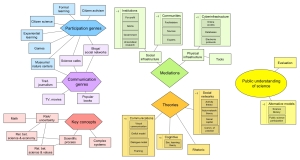For my candidacy exams, I’m focusing on two subject areas: public understanding of science (PUoS) and informatics of community science (or, how communities use cyberinfrastructure for science projects).
Both of these areas contain a wide variety of concepts, and there are many connections between the two. I’ve created a concept map to help me organize how these ideas fit together. You should be able to click on it for a legible version.
What I’ve tried to do here is connect up the concepts from various readings to some of the key ideas. Three key topics on the left (in hexagons) primarily come from the PUoS literature: participatory genres of science learning, more traditional “communication” genres, and some key concepts that are critical to address in order to have public understanding of science. These three represent important areas of focus in the PUoS literature.
Jumping to the right, the oval for PUoS is what I plan to do research on. I’m interested on how we can use online tools to improve PUoS. The general idea with this map is that we use the two diamonds (and connected ideas) in the center to get to this point. The topics in the diamonds are primarily from the informatics/community literature: physical and social components of community science networks, and theories for understanding these networks. These topics either mediate or theorize specific approaches to PUoS, so we can get to an endpoint where we can evaluate PUoS. Hopefully this will all make sense.
A good concept map shouldn’t need this much explanation, but this is a working draft, mainly intended as a tool to help me put a wide variety of readings together into some sort of coherent form. What I’d ideally like to do with this is connect up these concepts with the readings, which will add on another layer to this diagram. At least, that’s the plan.
